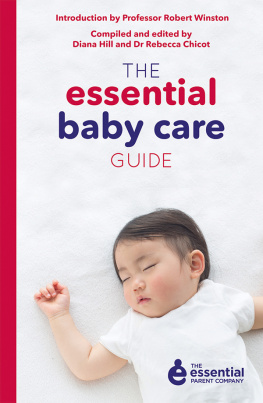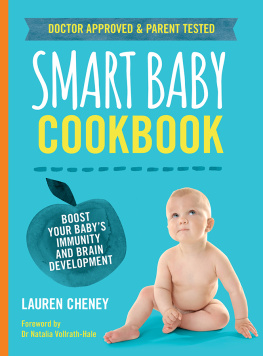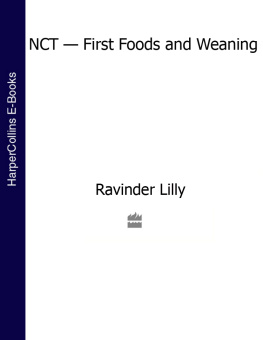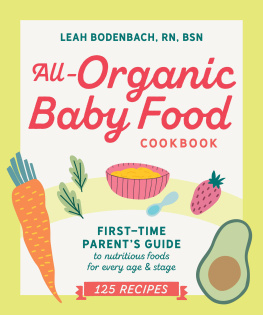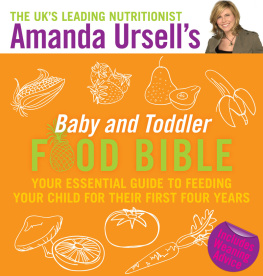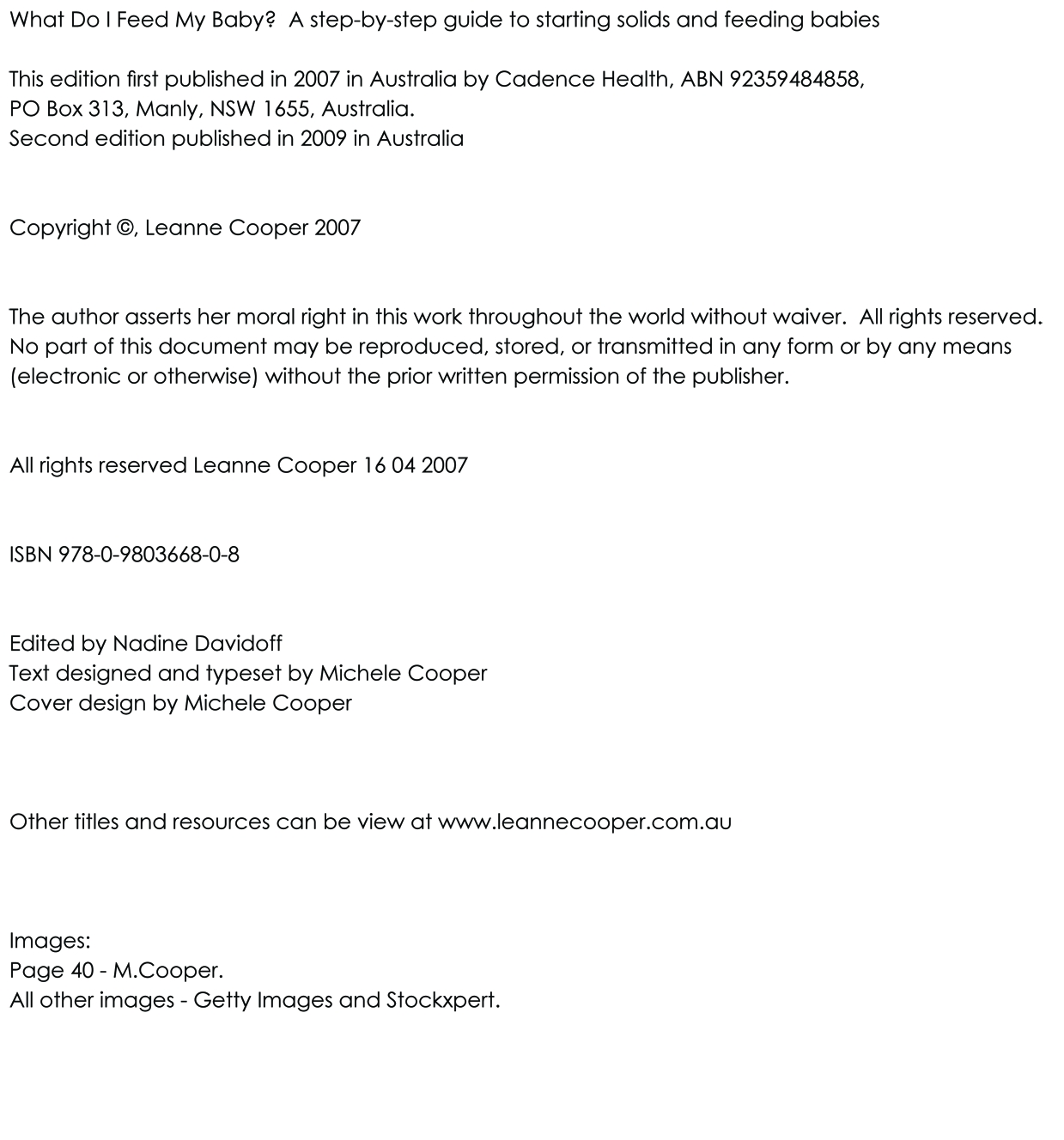About the author
Leanne Cooper, BA (Psych/Ed); Dip. Nut; Grad Cert Higher Ed.; Grad Cert Nut., gained her Bachelor of Arts in psychology and education from Auckland University in 1987. After travelling abroad for a number of years she returned to Australia, her childhood home, to continue her studies. Graduating with tertiary qualifications in education, health and nutrition, Leanne has now worked in education and health for over 20 years.
While designing health and education systems, Leanne also established her own successful nutrition practice where she originally worked with many high-profile national and international elite athletes. Although she is now not able to commit time to a private practice, Leanne still lectures in nutrition, psychology and management and runs her successful education business, Cadence Health. Leannes nutritional advice and support features on the Huggies websites worldwide and a number of Expert Panels. She also consults to a large number of health organisations and child-care centres. Leanne has devoted all of her working career to community education and health. She believes that getting nutrition right early on in life is the cornerstone to community health.
Leanne enjoys a unique lifestyle on the beautiful northern beaches in Sydney, Australia, with her husband and their two beautiful young sons, Zachariah and Samuel.
Acknowledgements
Thank you to:
My mother Glenise for all her proofing and fantastic literary input, your way with words is a true reflection of your kind and loving spirit; and my gorgeous sister Michele who has supported, directed and clarified this concept as well as her expertise in graphics and presentation.
Meals and menus for starting bub on solids
The following menus and meals provide ideas for how you may introduce solids; you can substitute our food choices for your own at any point. You may find that you have to substitute a food because of an intolerance or allergy, a food we have suggested isnt available in the supermarkets, or simply because it doesnt suit you or bub at the time.
The initial menus are based on an infant of about 6 months of age who shows all the signs of readiness for solids. Our meals and menus are guides only NOT rules and you may have to shift days to suit the age of your baby. Guidelines are flexible to allow for individal differences which may explain why they can seem so contradictory; furthermore, these can change frequently as does our understanding of babies of this age. Please also keep in mind that the introduction of foods differs from one culture, country, family and even organisation to another.
Trust yourself and bub!
Too often, we tend to listen to the well-meaning advice of others and over-ride our own intuition. By contrast, our philosophy is to fully support the instinctive knowledge of both mother/father and baby. Trust in yourself and your baby, be flexible, dont take on too much advice, and do what works best for you and your family! If in doubt, seek qualified advice.
Some tips before starting out
Nutritional tips
- When starting out, offer breast milk or formula first so bub gets all their nutrients each day.
- Introduce new foods only once every 35 days and always check for reactions.
- The top foods for allergic reaction include eggs, milk, seafood, nuts, soy and wheat (not in any order).
- Try starting initially with vegetables. Once you have achieved a good variety, then introduce fruit. Babies naturally prefer sweet and salty so be careful not to encourage a sweet tooth early on.
- Include bitter vegetables with sweet vegies and alter the ratios so that some meals are a little more bitter than others.
- Cover all your bases by selecting foods that have a wide variety of nutrients, for example look to offer different coloured foods. Because of their limited stomach capacity, choose healthy food for infants and cleverly combine foods for toddlers to ensure that they get the nutrients they need for growth and development.
- Remember that variety is one of the most significant factors in a healthy diet. It is also a way of fostering healthy attitudes towards food: children who are exposed to a wide variety early on are more likely to maintain healthy eating patterns into adulthood. This may also help you through the terrible twos where it is common for a child to refuse to try new foods or mixes of foods.
- Dont miss the boat. With the hectic pace of life, it is tempting to allow a baby or toddler to miss a meal, but dont allow yourself to fall into this trap. Every meal is as important as every bite. A regular supply of nutrients throughout the day will ensure that your little one has all the energy they need as well as all the building blocks for growth and development.
- Recognise quality foods. When first embarking on feeding baby solids, we tend to be enthusiastic and vigilant. Indeed, some of us even go the extra distance and use organic homemade foods. However, as the novelty of solids wears off and life becomes more hectic, many find it difficult to maintain these high standards; but dont fret, this is a natural progression. The important thing to remember is to be discerning with the quality of foods. Read labels carefully and check for added sugar, sugar levels, additives and added salt. Select wholemeal over white bread, natural yoghurts over dessert-type yoghurts and so on. Limit treats to outside the home.
- When starting solids begin baby on water in a sipper cup to avoid constipation.
Keeping it simple
- Remember that all babies are different. They eat different amounts, have different taste and texture preferences, and progress at different rates.
- Bubs who start solids earlier can take longer to get up to any great quantity.
- Avoid upset tummies by not pushing bub to eat too much initially. They will quickly learn to show you they are ready for more.
- Expect a mess; babies are generally very messy eaters.
- Food is fun. Treating food early on as a positive experience is important not just for baby but also for parents and caregivers. Encouraging babys enjoyment of food may mean getting in boots and all and allowing baby to feel the food, mix it around on their highchair table, some may even like to wear it! There are few sights as funny as a baby with green avocado horns sticking out of either side of their head.
Healthful tips
- Make your purees for storage thicker than you need to so you can thin them down and warm them up after being refrigerated with boiling water, breast milk or formula.
- Ice-cube trays are perfect for bubs starting on solids, you can even get specialised ones such as Baby Cubes that have individual flip-top lids (see stockists).
- When preparing purees to eat straight away, dont make them too thick; they should be soupy to start with until your little one is drinking water. This can help to reduce the likelihood of constipation.
- Use clean utensils. Whatever you use to feed baby, make sure the utensil is clean (sterilised, if possible, while baby is very young). In the initial stages, you might like to use a VERY clean finger and allow baby to suck the food as this is babys most familiar mouth motion. Then you can move onto a small baby spoon that has smooth edges. Again, allow baby to suck the food up rather than spooning it all in. NEVER be tempted to place solids in babys bottle.
- Warm, hot or cold? Most babies prefer food at room temperature, although some may prefer it slightly warmer, for example, at body temperature (which is the same as milk straight from the breast). Place babys bowl into a bowl of hot water to warm it to the desired temperature. Take care using a microwave oven as they tend to heat foods unevenly suddenly hitting a hot spot of food can be distressing and burn babys soft mouth.


